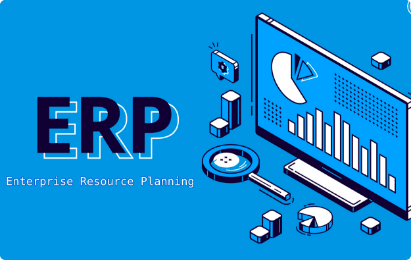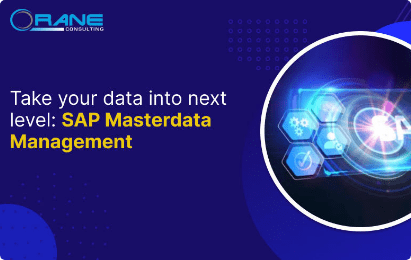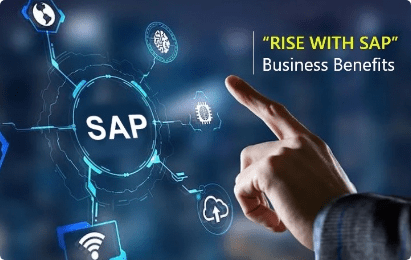There is a lot of hidden potential within an organization that can be uncovered by powering its SAP technology ecosystem with RPA. The faster value realization scope of RPA means that businesses can measure their ROI on their efforts in a noticeably short time frame. While we have identified 3 key areas, an organization can leverage the capabilities of an expert advisory for SAP and identify more focus areas for value generation with RPA.

Blog
Orane’s blog posts keeping you up to speed with what’s hot in the world of business.
Power Up your SAP Applications with RPA

Introduction:
For years, enterprise software has been at the forefront of enabling businesses to improve efficiency and drive more value from their operational models. As we progressed into the digital age and emerging technologies like RPA, AI, IoT, etc. began impacting both the consumer and enterprise technology landscape, enterprise software too began realizing new use cases for their capabilities by collaborating with new-age digital technologies. From uncovering the hidden potential of the software to empowering businesses to open new revenue streams, the collaboration is producing a new dimension of possibilities in the tech sector. One such example is powering up SAP applications with RPA or Robotic Process Automation.
SAP applications power the core of a business and an SAP implementation is often considered to be the equivalent of brain surgery. It has been immensely successful in driving a technology revolution amongst some of the world’s largest businesses. In fact, studies prove that nearly 77% of the transactional revenue globally passes through an SAP system.
RPA has slowly but steadily made its impact felt in the global automation space across several industries. From freeing up the human workforce from mundane software configuration jobs in its initial days to autonomous transaction workflow management and cognitive job processing today, RPA is empowering thousands of enterprises to improve their work efficiency. In fact, by 2022, Gartner estimates that nearly 90% of large organizations globally will utilize RPA in some form in their operations.
So how can the world’s leading class of enterprise applications and one of the hottest emerging digital technologies work together to drive more value for businesses? While SAP has its own fair share of intelligent automation and AI-enabled capabilities, today we focus on how RPA can power up SAP applications within an enterprise.
1. Ensuring Consistency of Data
For large enterprise applications like SAP ERP, there is no shortage of large information and data exchange avenues in their daily operations. From intra-application module data transfer to liaising with other SAP or 3rd party business applications, there is a need to ensure that the right data with the right intrinsic parameters are fed into the right data stream for consumption by different applications. Inaccurate data entry or delayed record updates can lead to huge consistency issues for the data and can result in different business systems processing and reporting wrong results for the business. RPA bots can ensure that this does not happen as they can autonomously handle data consistency validation by parallelly running record checks from multiple data sources, download data into spreadsheets for quicker analysis, and report inaccuracies. All this can be done faster and with zero errors when compared to the painstaking manual effort required for humans to do the same data consistency validation.
2. Facilitating Seamless Migration
Every enterprise invests in upgrading or replacing its core business systems from time to time. These could be migration from 3rd party business systems to SAP or from one SAP business system to another like for example from SAP-to-SAP S/4 HANA. Each of these initiatives will involve a complex migration exercise that is often performed manually. This manual exercise has higher chances of errors creeping in and the tasks are extremely monotonous thereby wasting considerable human effort which could have been utilized elsewhere for more valuable achievements. RPA can handle the migration exercise seamlessly as software bots can be easily programmed to quickly scan, assess and migrate data from the old system into the right module or repository of the new application. This will reduce costs and eliminate risks from human error.
3. Bolster Supply Chain Operational Efficiency
One of the key pillars of a business where SAP applications make a significant impact is in the supply chain and procurements section or department. Sometimes, large businesses may have to evaluate thousands of product quotes or logistic data from multiple vendors to finalize on production timelines or delivery commitments. Manual performance of this evaluation process can be plagued by inefficiencies and risks of human error. There is also a need for an extensive follow-up process for orders, invoice availability, PO fulfillment, etc. RPA bots can seamlessly bring in an automated environment to manage these supply chain responsibilities thereby alleviating the human workforce to focus on higher-value jobs in this department. They can run a quick comparison of quotes, identify variations or inconsistencies in orders or invoices, calculate availability and delivery timelines of raw materials as well as finished goods, and can manage fulfillment tracking of various purchase orders and invoices.
Subscribe to our communication
You agree to receive newsletters, marketing communication and latest developments from us.

6 Tips to Boost Your Business Performance
- August 19, 2022

How ERP Implementation is Essential for Businesses? – Top 5 Reasons
- August 19, 2022

Take your Data into next level
- August 19, 2022

Rise with SAP: Business Benefits
- August 19, 2022

SAP Masterdata Management
- August 19, 2022

